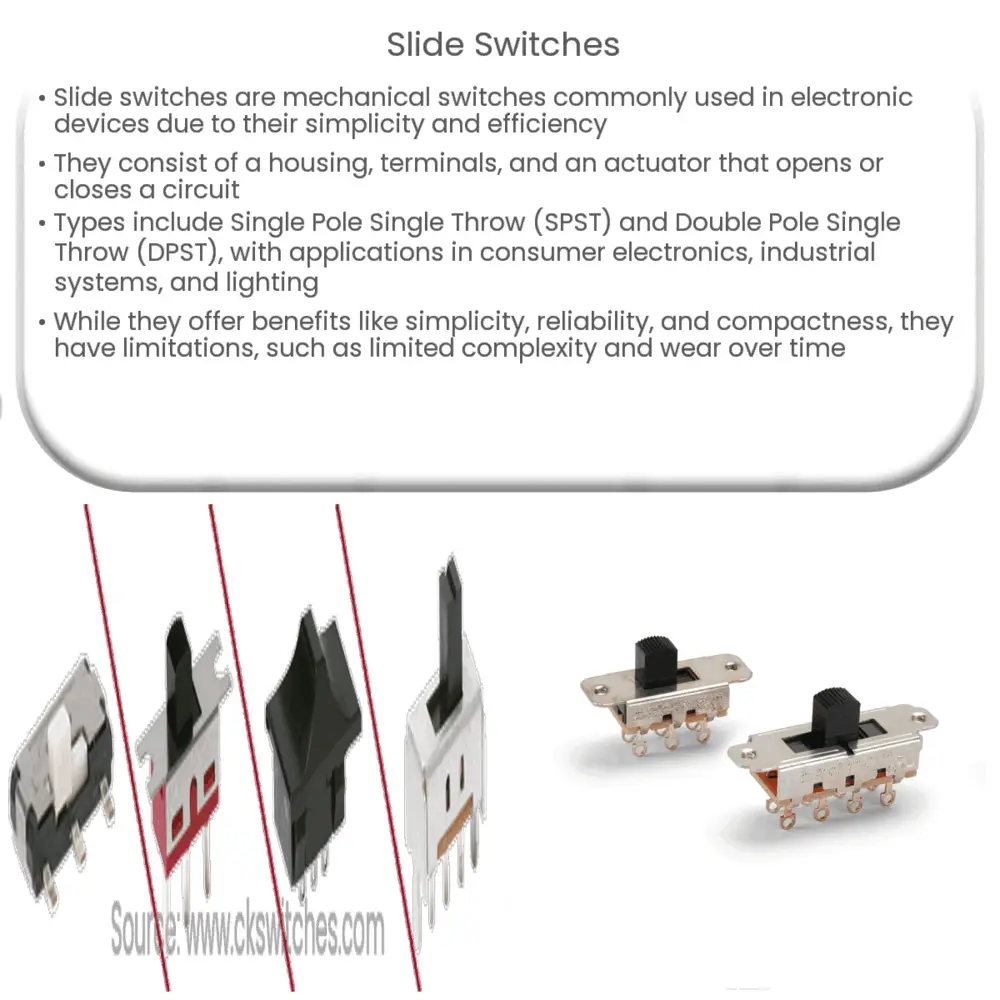Explore the fundamentals of slide switches: their structure, working principle, types, applications, advantages, limitations, and maintenance.

Introduction to Slide Switches
A slide switch is a type of mechanical switch widely used in various electronic devices. Renowned for their simplicity and efficiency, these switches operate with a slider that moves (or “slides”) back and forth to open or close an electrical circuit.
Structure and Working Principle of Slide Switches
At its core, a slide switch consists of several components:
- The housing: This is the outer shell that protects the internal parts of the switch from physical damage and environmental conditions.
- The terminals: These are the contact points where the switch connects to the electronic circuit.
- The actuator: Also known as the slider, this is the part that users move to open or close the circuit.
The operation of a slide switch is simple and straightforward. When the slider or actuator moves, it changes the connection between the terminals, thereby opening or closing the electrical circuit. It’s this straightforward functionality that makes slide switches a popular choice for many devices.
Types of Slide Switches
Slide switches can be categorized into two primary types based on their functionality:
- Single Pole Single Throw (SPST): This is the simplest type of slide switch, consisting of one input (pole) and one output (throw). It can be in either of two states – ON or OFF.
- Double Pole Single Throw (DPST): This type of switch has two inputs (poles) and two outputs (throws). It controls two circuits simultaneously, but still only has two states – ON or OFF.
Furthermore, slide switches come in various sizes and designs to suit different applications. Some switches feature a larger slider for ease of use, while others may be miniaturized for use in compact electronic devices.
Applications of Slide Switches
Slide switches are widely used across a spectrum of applications due to their simplicity and reliability. They are commonly found in:
- Consumer electronics like radios, televisions, and video game consoles.
- Industrial control systems.
- Lighting fixtures.
Their widespread use underscores the important role they play in enabling the functionality of various devices.
Advantages of Slide Switches
Slide switches offer several advantages, including:
- Simple operation: The intuitive design of slide switches makes them easy to operate, even for individuals unfamiliar with the device they’re used in.
- Reliability: These switches typically have a long lifespan and can handle a large number of switching cycles without failing.
- Compactness: Due to their simple design, slide switches can be made very small, making them suitable for devices where space is at a premium.
- Versatility: Slide switches can be used in a broad range of applications, from household electronics to industrial machinery.
Limitations of Slide Switches
Despite their many benefits, slide switches also have certain limitations:
- Limited complexity: As they typically offer just two positions – ON and OFF, slide switches are not suitable for applications that require multiple states or analogue control.
- Physical wear: As mechanical devices, slide switches are subject to wear and tear over time, which can eventually lead to failure.
Maintenance of Slide Switches
Slide switches, like all mechanical components, require maintenance to ensure optimal performance and longevity. This typically involves cleaning the contacts to remove any accumulated dust or grime and checking the mechanical parts for signs of wear. For most consumer applications, however, slide switches are generally maintenance-free for the lifespan of the product in which they’re installed.
Conclusion
In conclusion, slide switches play a critical role in many electrical and electronic systems. Despite their simple design and operation, these components are indispensable in our everyday technology, contributing to the functionality and user experience of various devices. Their wide range of applications, from consumer electronics to industrial control systems, testifies to their versatility and reliability. While they do have certain limitations, their benefits far outweigh their drawbacks, making them an enduringly popular choice among device manufacturers and engineers.

